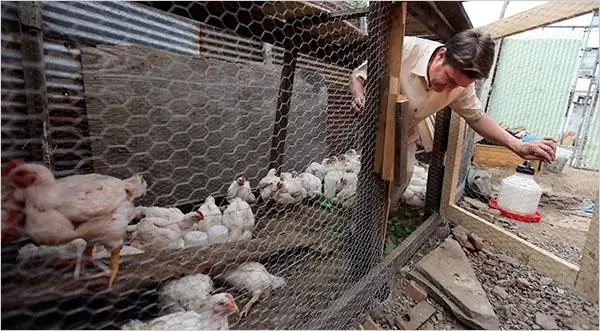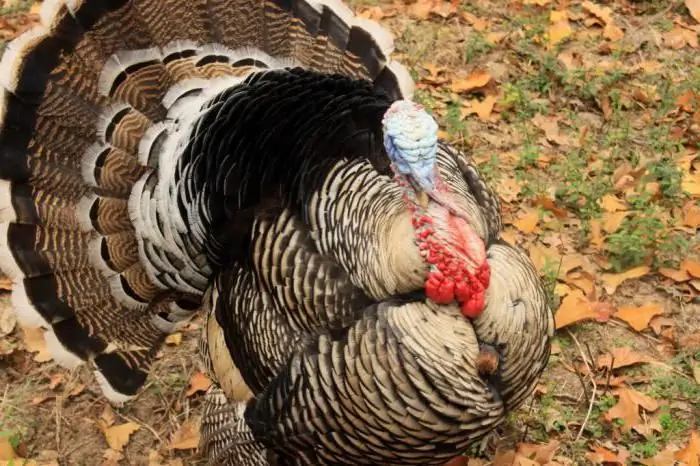2025 Author: Howard Calhoun | [email protected]. Last modified: 2025-01-24 13:10:25
Turkeys, in fact, are a type of poultry. Breeding this living creature in a suburban area or on a farm, of course, is quite profitable. In some cases, a broiler turkey can reach a weight of 25 kg. Raising such a bird is relatively easy. However, an entrepreneur who decides to organize a farm of such specialization, of course, must know and strictly observe all the required technologies for keeping turkeys.
Where to start?
Successful turkey farming will, of course, only if the farmer initially manages to acquire good he althy young. Of course, the chicks can also be hatched independently - in an incubator. However, experts still advise beginners, when organizing a farm, to purchase not eggs at a poultry farm, but young animals. At the same time, it is better to buy not daily poults, but grown ones - two weeks or monthly. Such chicks are already warm enough and are immune to many diseases. And, consequently, the attack in the herd will not be too big.

The best breeds of broiler turkeys
Purchasingchicks, you should pay attention not only to their age. A successful organized farm will be exclusively subject to the correct choice of the breed of turkeys. The selection of this bird in our country and abroad is quite active. A lot of broiler breeds of turkeys have been bred. At the same time, the most popular among farmers today are:
- BIG-6.
- Universal.
- Heedon.
- White broad-chested.
BIG white broiler turkeys can reach a weight of 22-25 kg. At the same time, they gain muscle mass quite quickly. Such a bird reaches slaughter weight already at the age of 90 days. The plumage of the BIG is pure white. There is only a small black spot on the chest.
The station wagon was bred by breeders of our country. Therefore, this bird is very well adapted to the climatic conditions of Russia. By the time of slaughter, such hybrids can reach a weight of 18 kg.

Headon crosses were bred in the Netherlands. The weight of a broiler turkey of this breed can reach up to 20 kg. Such a hybrid gains body weight quickly. But it also has one significant drawback. Youngsters, unfortunately, usually have a very large lunge.
White broad-breasted turkey reaches a weight of 20-25 kg. The advantages of this breed include, first of all, the high palatability of meat. The disadvantage of this cross is considered whimsical content and a tendency to disease.
Building a poultry house
How should broiler turkeys be kept on a farm? cultivationat home, this bird is produced, of course, only in the most suitable and convenient room for it. In any case, the barn must exactly meet all the necessary requirements. In the turkey house, it is mandatory to provide:
- good lighting;
- ventilation;
- heating.

Of course, among other things, you should properly equip the house. It should be equipped with perches, nests, feeders and drinkers. The floor in the turkey house is recommended to be solid plank. Above ground level, it should be raised by about 20-25 centimeters. A thick layer of straw should be laid on top of the floor. Feeders for turkeys should be mounted on the wall at the level of the back of the bird. This will prevent scattering and trampling of feed, and, therefore, save the farmer from unnecessary costs. Drinkers in the barn are usually placed at the neck level of the turkeys.
The windows in the poultry house are placed in such a way that during the day the floors in it are illuminated throughout the area. Ventilation in the turkey house is supplemented with a valve. This helps to avoid hypothermia of the bird in the winter. A broiler turkey, in comparison with the usual one, according to most farmers, is a rather tender animal and does not have very good he alth.
Feeding rules for turkeys
Broiler poultry diet, of course, should be as balanced and high-calorie as possible. Only in this case, turkeys will quickly gain weight. 70% of the bird's diet should be feed,containing a large amount of proteins. It can be, for example, cereals or legumes. In particular, turkeys are often given oats and buckwheat. It is mandatory to feed this bird and cake. It is believed that germinated wheat is also very useful for such agricultural animals.

Mineral and vitamin balance in the body of a bird such as a broiler turkey, farmers usually maintain with the help of meat and bone meal and fish oil. Of course, you should feed livestock and green fodder. In the summer, the bird is given chopped grass, tops of carrots and radishes, lettuce and cabbage. In winter, turkeys should receive silage and spruce needles.
Feeding time
The most high-calorie food for broilers is usually given at night. In this case, the bird will gain weight faster. Turkey stirrers are most often made only during the day. Of course, you should always feed the bird at the same time.
What rules must be observed when keeping turkeys without fail
In order for the bird to feel as comfortable as possible in the barn and not get sick, the owner of the household plot should take care of the following conditions:
- nests in the barn should be placed in dark places;
- perches are installed at a height of approximately 70 cm from the floor level;
- ash pans should be installed in the house;
- drinkers and feeders should be cleaned regularly;
- broilers should be kept separate from any otherfarm poultry.
Before the barn for turkeys, it is desirable to make a paddock. But letting the bird out for the whole day, of course, is not worth it. Otherwise, the turkeys will not gain weight.

Reproduction
Many farmers are also interested in ways to increase the livestock of poultry such as broiler turkeys on the farm. Breeding this animal is a relatively difficult task. Like chickens, the offspring of turkey crosses, unfortunately, do not adopt the high productive qualities of their parents. You can get good young from eggs laid by a bird only if it is not a hybrid, but belongs to some good meat breed.
In principle, it is quite possible to get cross-broiler chicks in an incubator on your own. But in this case, the eggs will have to be bought at the poultry farm. They cost, of course, cheaper than turkeys. But it is quite difficult to breed chicks from them without loss without proper experience.

Turkey eggs should be incubated with strict observance of the prescribed temperature and humidity conditions. The offspring of this bird is born approximately 26-29 days after being placed in the apparatus. Actually, the incubation of turkey eggs itself is divided into four main periods. From the first to the eighth day, the temperature inside the apparatus should be 37.5-38 degrees, and the humidity should be 60-65%. Turn the eggs at this time at least six times a day.
Temperature and humidity parameters for the other threeperiods can be viewed in the table below.
| Period | Temperature, degrees Celsius | Humidity | Coup |
| 9-14 days | 37.7-38 | 45-50% | 4-6 times |
| 15-25 | 37.5 | 65% | 4-6 times |
| Hatching | 37 | 65-70% | - |
Starting from day 15, eggs should be cooled for 10-15 minutes every day. Do not perform this procedure only during the hatching period.
Broiler turkeys: raising young stock
After the chicks hatch, they should be placed in boxes or a special brooder and provided with round-the-clock lighting. This will reduce the possible lunge to a minimum. A day after hatching, the lamp in the box or brooder can be turned off for half an hour. Further, the lighting time is reduced by another 30 minutes every day.
Turkey litter should be changed as it gets dirty. Food and drink in a box or brooder should always be present in the chicks. At first, young animals should be fed with a special Start mixture. You can also offer chopped eggs and cottage cheese to the chicks. For the first three days, turkeys are fed not with raw water, but with green tea.
Possible diseases
Broiler turkeys, photos of which are presented in the article, as alreadymentioned, especially good he alth, unfortunately, do not differ. This bird can get sick quite easily. That is why it is so important to strictly follow all the necessary rules for its content.
Most often broiler turkeys fall ill:
- Tuberculosis. In this case, the bird behaves sluggishly and apathetically. Nodules appear on the skin of turkeys. Feces become liquid.
- Smallpox. This dangerous disease is characterized primarily by the ruffled feathers of the bird and lowered wings. Later, characteristic smallpox spots appear on the skin of turkeys.
- Mycoplasmosis. A broiler turkey that has caught this infection loses its sight. At the same time, the bird has discharge from the nose and eyes.

It is very difficult to treat diseases in broiler turkeys. At the same time, any infection can lead not only to a decrease in productivity, but also to the death of birds and the loss of livestock. That is why the owner of the farm should be as careful as possible to ensure that the turkeys do not get cold, do not eat low-quality food and do not drink dirty water. Subject to all technologies for keeping this bird, the risk of any diseases in the herd can be almost completely reduced to zero.
Recommended:
Levkoy: growing from seeds, planting and care, growing features

The most famous flower of the levka, grown from seeds in our gardens, has the scientific name Matthiola incana. The plant was first described by the Italian botanist Pietro Mattiole around the middle of the 16th century. There are variants of annual and perennial plants. Height - between 20 and 80 cm. In this case, the plant can have both single stems and be a shrub type. The root is shallow. It is slightly branching in the plant
How to distinguish a turkey from a turkey: appearance, bird behavior, difference

The most valuable is the meat of 5-month-old turkeys, at which time the feathered one weighs 12 kg. Non-breeding males are sent for slaughter, the identification of which is necessary at the earliest possible age. That is why the question of how to distinguish a turkey from a turkey is far from being idle and is of great importance in poultry farming
Broiler chicken: growing at home

This article explores the benefits of running a broiler chicken business. It also contains information on how to properly organize the process of breeding broiler chickens at home
How to grow broiler chickens at home successfully?

Home raising broiler chickens has its own characteristics: they do not need large open aviaries or pastures. A ventilated cage, proper litter and good compound feed are the key to a quick weight gain for broilers
The origin of the turkey. Turkey (bird): photo

The origin of the turkey is not a very difficult question. The wild progenitors of this wonderful bird with delicious meat still roam the forests of America and Africa today. Sometimes forest and steppe males even join domestic flocks, resulting in very strong and hardy chicks

